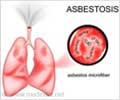Malignant mesothelioma is a very aggressive tumor which is found resistant to most of the treatment, which is increasing in frequency throughout the
Malignant mesothelioma is a very aggressive tumor which is found resistant to most of the treatment, which is increasing in frequency throughout the world. The main causative agents for the development of Malignant mesothelioma is exposure to asbestos, recently a virus, simian virus 40 (SV40) is also found to be a causative agent for development of this tumor.
Many people with malignant mesothelioma have worked or lived in places where they inhaled or swallowed asbestos. After being exposed to asbestos, it usually takes a long time for malignant mesothelioma to occur. In a report in the current issue of Lancet it is reported that mesothelioma has an unusual molecular pathology with loss of tumour suppressor genes being the predominant pattern of lesions, especially the P16INK4A, and P14ARF, and NF2 genes, rather than the more common p53 and Rb tumour suppressor genes.In a previous report from earlier this month from the UC Davis Department of Public Health Sciences suggested that that risks from exposure to naturally occurring asbestos though low was real and was to be taken seriously. Marc Schenker, professor and chair of and the study's senior author said:"This study provides important supportive evidence that naturally occurring asbestos causes mesothelioma - and public efforts should now shift to understanding the risk and how we can protect people from this preventable malignancy."
Mesothelioma kills about the same number of Americans each year as passive smoking. About 2,500 people a year die from mesothelioma in the United States, according to National Institute of Occupational Safety and Health statistics.
Mortality in Britain from Mesethelioma rose from 153 deaths in 1968 to 1,848 in 2001 and is still increasing and according to a study reported in Feb this year from UK, the rate will begin to decline by 2015. The study predicted that the peak in mortality in UK, will come between 2011 and 2015, the highest number of deaths per year being between 1,950 and 2,450. After that peak, the mortality rate is expected to fall rapidly to a background level, depending on what residual exposure to asbestos.
Professor Peto who conducted this study says: "The peak in mesothelioma deaths will be earlier and at a lower number than formerly thought. The abrupt reduction in asbestos exposure in 1980 has altered the lifelong patterns of exposure that people have experienced. This makes the previous age-related models inaccurate. Our new model for predicting mesothelioma mortality rates is more complex and takes account of the varying exposure to asbestos of different age groups at different times of their lives." In brief, Mesothelioma is a lethal cancer that is caused by long-term or high level exposure to asbestos dust and fibers. There is currently no cure for this cancer. It can affect the heart, lungs, or abdominal regions. The lifespan of sufferers can be reduced to a matter of months from the onset of the symptoms, but the symptoms can take many decades to manifest from the exposure to asbestos. The understanding of the disease process is important for both prevention and sure of the disease.
Further Information from Medindia on Mesethelioma
Advertisement
By-Oscar Auerbach, Arthur Purdy Stout, Edward Cuyler Hammond, Lawrence Garfinkel, 1964
Advertisement
Lung cancer is the uncontrolled growth of abnormal cells in the lung. Majority of people who get lung cancer have been cigarette smokers, but not all people who smoke get lung cancer. And, some people who have never smoked get lung cancer. Normal lung tissue is made up of cells that are programmed by nature to create lungs of a certain shape and function.
https:www.medindia.net/patients/
patientinfo/lungcancer_about.htm
Further Information from Medindia on Mesethelioma
In men who die of lung cancer (squamous and undifferentiated), all of whom were smokers, the remainder of the epithelial lining shows changes that may be considered as preliminary stages to the development of lung cancer, including early invasion. There are few such changes in nonsmokers, but they increase rapidly with the amount of cigarette smoking.
By-Oscar Auerbach, Arthur Purdy Stout, Edward Cuyler Hammond, Lawrence Garfinkel, 1964
Malignant mesothelioma is a disease in which the cancer cells are found in the pleural area (Pleura is the thin layer of tissue that is between the chest cavity and the lungs) or the peritoneum (peritoneum is a thin layer of tissue that lines most of the organs in the abdomen). Mesothelioma has so far been an incurable cancer and once diagnosed most patients will die within a year.
www.medindia.com/patients/
patientinfo/
mesothelioma_cancer_intro.htm










